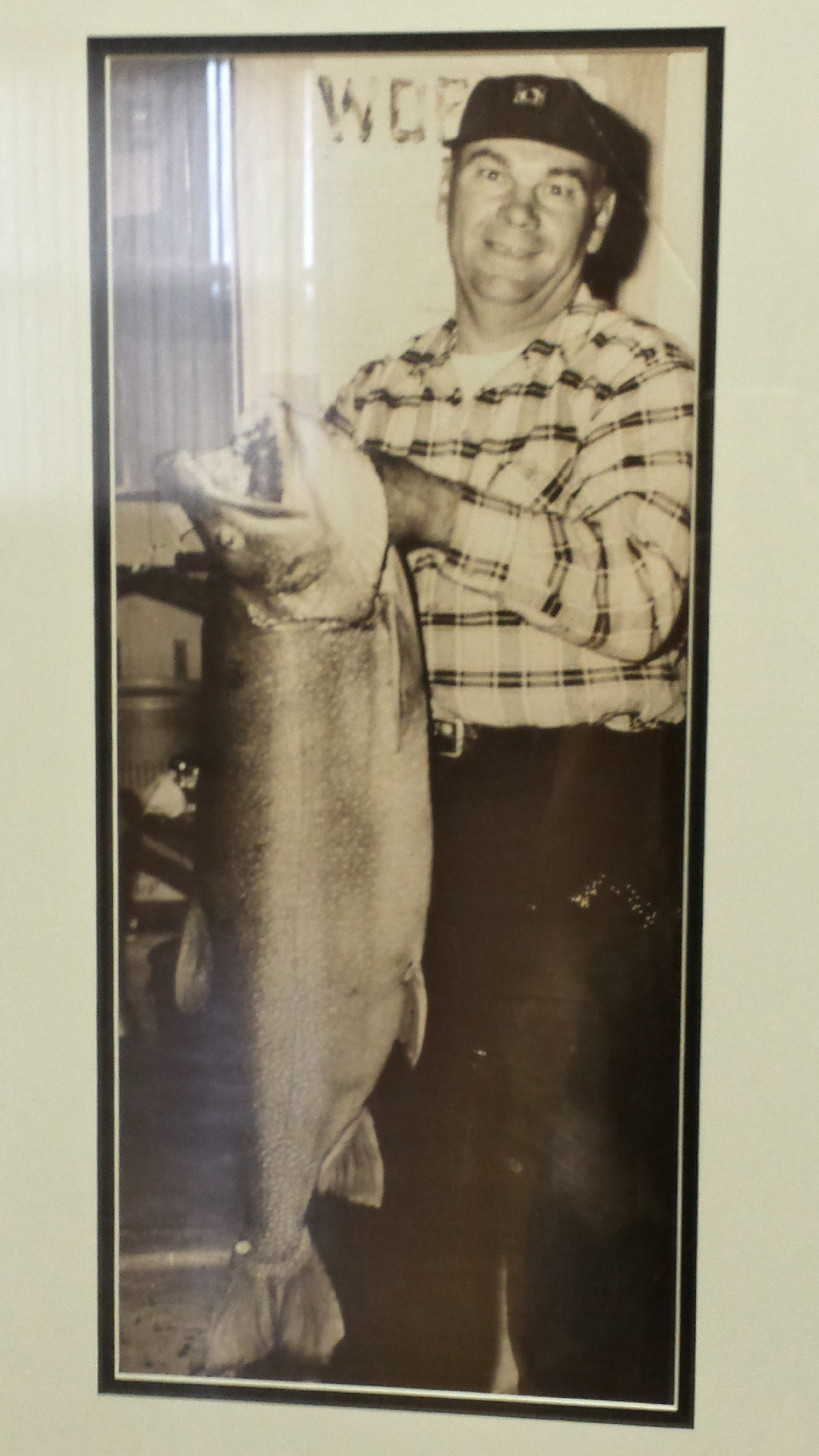BIG GREEN LAKE has seen its fair share of monster lake trout caught over the years. Above left, Joseph Gotz holds up his Wisconsin inland record lake trout, which he caught June 1, 1957. It weighed 35 pounds, 4 ounces.
Coldwater Fish Advisory Committee aims to maintain Big Green Lake’s legacy
by Connor Cummiskey
One of the largest lake trout caught over the last 40 years in Green Lake was netted in June. It measured in at 41 inches and 28.9 pounds.
While not a record breaker, this fish still made waves in the fishing community.
It may stir up memories of the history of Green Lake: A history Green Lake’s Coldwater Fish Advisory Committee would like to preserve.
“This is the history of Green Lake, but guess what [the fish] are still here,” Coldwater Fish Advisory Committee member Stephen Siders said.
That does not mean that the fish, particularly lake trout, which make Green Lake such a popular fishing hole, will remain forever.
“That is why we need a Coldwater Fish Advisory Committee to make sure that they continue to be here,” Siders said.
The committee intends to give a voice to cold-water sports’ fishermen and other community members who wish to maintain Green Lake’s reputation.
“The reason for the Coldwater Advisory Committee is to ensure that we meet our quotas and monitor water and fishery conditions,” said Mike Norton, owner of Mike Norton’s Fishing Adventure.
Quotas are the amount of each species of fish that are stocked, or introduced, into the lake.
Lake trout were first stocked in Big Green Lake in 1886, and continued to be until 1944. At that time, the stocking stopped due to the fish being difficult to catch.
In 1952, the local fishermen discovered the secret to catching the lake trout during the summer months.
After Major Turnbull of New York arrived in 1951 and was able to catch the fish, the local anglers figured out how he did it.
By cornering him and forcing him to cut his line in shallow waters, the fishermen were able to dig up the lures he was using.
Unfortunately, the lures on the end of Turnbull’s line were filed clean of their names.
But then a local jeweler took a look at them.
The jeweler soaked the lures in acid to reveal that they were Sutton Spoons.
Thus, the fishermen learned that Sutton Spoons, and other thin silver spoons, were best for catching lake trout.
In 1953, lake trout were again stocked in Green Lake. Restocking began as a response to the following explosion of fish being caught.
The boom was similar to the gold rush that had inspired prospectors to travel west in hopes of striking it rich.
Instead, anglers came from across the state in hopes of catching the “big fish.”
By 1961, 50,000 lake trout were being stocked in the lake, according to a draft of the “Environmental Assessment for Landlocked Atlantic Salmon Stocking in Big Green Lake, Wisconsin.”
Too many of the lake trout being stocked made for an unbalanced ecosystem in the lake.
That year, Vern Hacker expressed in a report that 25,000 fish would be more sustainable.
“He also talked about a second cold-water species,” Norton said.
Cold-water species are fish that live close to the bottom of the lake. Lake trout are one such fish.
A second species helps take the pressure of predation and fishing off of the lake trout.
That way, they could thrive, live longer and grow larger.
Brown trout were one of the species stocked in the lake to serve this purpose.
They fulfilled this role until recently.
“The brown trout do not survive to their second year,” Norton said.
It is unclear what is causing their shortened-life spans.
One possibility is an increase in predation.
“The cool-water fishery is much more dominant than it was years ago,” Norton said. “[Specifically], we are talking northern [pike] and musky.”
To better balance the cold-water fishery, the committee proposes a pilot stocking of landlocked Atlantic salmon.
“These landlocked salmon create a stir even in lake Michigan,” Norton said.
In Green Lake, the landlocked salmon could increase tourism. Such a unique fishing opportunity likely would draw anglers from across the state, or even further.
The committee has reviewed studies performed on landlocked salmon being stocked in Michigan and Maine.
Its findings point toward these salmon surviving better than brown trout.
An experiment is being proposed to see if the salmon truly are a viable option for helping Green Lake.
After four years of stocking the salmon, the committee hopes it will create a greater “Return to Creel” for anglers.
“Return to Creel” is the term for the rate of fish being caught per number of fish stocked.
Green Lake is one of the few places an experiment like this can be successful, because the water is so deep.
“People look at the lake and they do not realize the volume,” Norton said. “They look at it horizontally.”
That is why Green Lake’s Coldwater Fish Advisory Committee is so dedicated to preserving the fishing culture of the lake.
According to a draft of the environmental assessment, the committee hopes to reestablish Big Green Lake “as the premiere inland cold-water fishery destination in the Midwest.”
